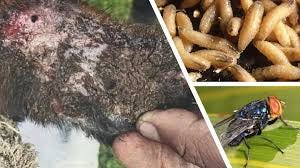U.S. to Battle Flesh-Eating Screwworm Flies in Texas with Sterile Insect Blitz
In a move to combat a gruesome pest, the USDA is preparing to unleash millions of sterile flies over Texas and parts of Mexico to eradicate the New World Screwworm (NWS), a parasitic insect whose larvae burrow into the flesh of living animals and, in rare cases, humans. The resurgence of this once-vanquished fly has raised alarms about agricultural losses, public health risks, and the potential vulnerabilities of open borders in facilitating its spread. Could this outbreak hint at a darker possibility, such as entomological warfare?
The Screwworm Menace Returns
The NWS fly, known scientifically as Cochliomyia hominivorax, is a nightmare for livestock producers. Female flies lay eggs in open wounds or orifices of warm-blooded hosts, including cattle, horses, pets, and occasionally humans. Upon hatching, the maggots feed on living tissue, causing severe infections that can be fatal if untreated. Endemic to regions like Cuba, Haiti, and parts of South America, the fly was eradicated from the U.S. in 1966 through a groundbreaking sterile insect technique (SIT), which disrupted the pest’s reproductive cycle.
On May 2025, the USDA confirmed the fly’s reemergence in Texas, following an outbreak in southern Mexico. The agency estimates that NWS infestations cost Southwestern livestock producers $50–100 million annually before its earlier eradication, underscoring the urgency of the current response. To counter the threat, the USDA will breed millions of male flies, sterilize them with radiation, and release them to mate with wild females, producing unfertilized eggs that halt population growth. A new breeding facility in southern Mexico, set to open in July 2026, and a distribution center in southern Texas will support this effort
The Centers for Disease Control and Prevention has warned that individuals with open wounds—especially those working with livestock, sleeping outdoors, or recovering from surgery—are at higher risk of infestation. The fly’s ability to target humans, though rare, adds a chilling dimension to the outbreak.
Entomological Warfare: A Deliberate Threat?
Entomological warfare (EW), the use of insects as biological weapons, has a grim history. From Japan’s World War II deployment of plague-infected fleas against China to Cold War experiments with disease-carrying mosquitoes, insects have been weaponized to disrupt economies and populations. While no evidence suggests the NWS resurgence is an act of EW, the fly’s destructive potential makes it a plausible candidate for such tactics. Its larvae’s ability to devastate livestock could cripple agricultural sectors, while human infestations could sow panic.
Theoretically, a hostile actor could release NWS flies to target a nation’s food supply or public health. However, experts caution that natural reintroduction is more likely than deliberate sabotage. Still, the fly’s sudden reappearance after decades of absence raises questions about how such a pest could cross borders undetected.
Open Borders and the Spread of Pests
The NWS outbreak in Mexico, followed by its spread to Texas, has sparked speculation about the role of open borders—whether through trade, migration, or illicit activities—in facilitating the fly’s return. Several factors suggest how porous borders could contribute:
• Livestock Smuggling: linked the Mexican outbreak to illegal cattle smuggling, often tied to drug cartels. A 2024 case involving an infested cow prompted U.S. border restrictions on cattle, horses, and bison imports from Mexico. Uninspected livestock could carry NWS eggs or larvae, bypassing biosecurity measures.
• Human Travel and Migration: The CDC notes that travelers to endemic areas risk carrying NWS flies or eggs, particularly on clothing or belongings. Increased cross-border movement, including migration or tourism, could inadvertently introduce the pest, especially if health screenings are lax.
• Trade and Environmental Gaps: Legal trade routes, if poorly monitored, may also serve as vectors. The flies’ reappearance in Mexico suggests weaknesses in regional biosecurity, possibly exacerbated by climate changes that favor the pest’s survival. Open borders, in the context of insufficient quarantine protocols, heighten the risk of pest introduction.
The USDA’s swift response, including temporary border restrictions and the SIT program, demonstrates proactive containment. However, the outbreak highlights the challenges of securing borders against biological threats, whether natural or intentional. While open borders facilitate economic and cultural exchange, they also demand robust biosecurity to prevent pests like the NWS from gaining a foothold.
Looking Ahead
As the USDA gears up to flood Texas skies with sterile flies, the fight against the NWS is a reminder of nature’s tenacity and humanity’s ingenuity. The sterile insect technique, proven effective decades ago, offers hope for eradicating the pest once more. Yet, the fly’s return underscores the need for vigilance in an interconnected world, where borders—open or not—can become pathways for invasive species.
Whether the NWS resurgence is a natural setback or a warning of broader vulnerabilities, it prompts critical questions about biosecurity, border policies, and the specter of entomological warfare. For now, Texans and their livestock await relief from a pest that, left unchecked, could spiral into a far greater crisis.


